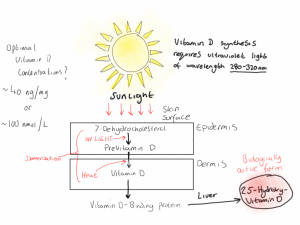Vitamin D is actually a hormone and not a vitamin. Vitamin D is synthesised in the skin of humans in a reaction catalysed by ultraviolet light. The first step in the synthesis of vitamin D is the conversion of hepatically formed 7-dehydrocholesterol to previtamin D in the epidermis of the skin. When the skin is exposed to ultraviolet radiation with a wavelength of between 280 and 320 nm, photochemical transformation of the 7-dehydrocholesterol to previtamin D occurs. The previtamin D then isomerises under the regulation of heat to vitamin D3 (cholecalciferol). Vitamin D then binds to the vitamin D binding protein (transcalciferin) and enters circulation. Cholecalciferol is hydroxylated to 25-hydroxyvitamin D in the liver and this is considered the active biomarker of vitamin D status, and the most biologically active form. Further metabolism of 25-hydroxyvitamin D can occur in the kidney producing 1,25-dihydroxyvitamin D, which also has cellular effects (figure 1).
Both vitamin D3 (cholecalciferol) and vitamin D3 (ergocalciferol) are present in foods. However, they are not present in high amounts in foods commonly consumed in the typical Western diet. Further, there is doubt that even high quality diets containing vitamin D rich foods can supply adequate vitamin D for metabolic needs. Preformed 25-hydroxyvitamin D is also present in foods, and because this is more biologically active, it may be more effective than either cholecalciferol or ergocalciferol at raising plasma levels of 25-hydroxyvitamin D. However, it is unclear if it is present in high enough concentrations in in food to maintain optimal 25-hydroxyvitamin D. Current estimations suggest that perhaps it is not. Therefore for the vast majority of people living in developed nations the principle source of vitamin D is therefore the synthesis of the vitamin in the skin through the action of ultraviolet light. In winter vitamin D deficiencies are therefore a real possibility for many individuals.
Seasonal variations in vitamin D have been observed and reported in the literature. Generally as ultraviolet radiation levels fall in the winter months, plasma levels of 25-hydroxyvitamin D fall concomitantly. Studies have investigated the differing 25-hydroxyvitamin D levels of indoor and outdoor workers1. As expected outdoor workers showed greater plasma levels of 25-hydroxyvitamin D than indoor workers in all seasons. However the highest plasma levels of 25-hydroxyvitamin D were observed in October (~55 to 60 nmol/L) and November (~80 nmol/L) in the indoor and outdoor workers, respectively. This is interesting because peak ultraviolet light in the study region (Dublin) was recorded as July (15,000 counts UVR per month). Therefore the peak plasma levels of 25-hydroxyvitamin D might not correlate precisely with peak ultraviolet exposure. It is likely therefore that the autumn sun is strong enough to continue vitamin D synthesis in latitudes of 56°30’N, which continue to accumulate well into autumn.
RdB

